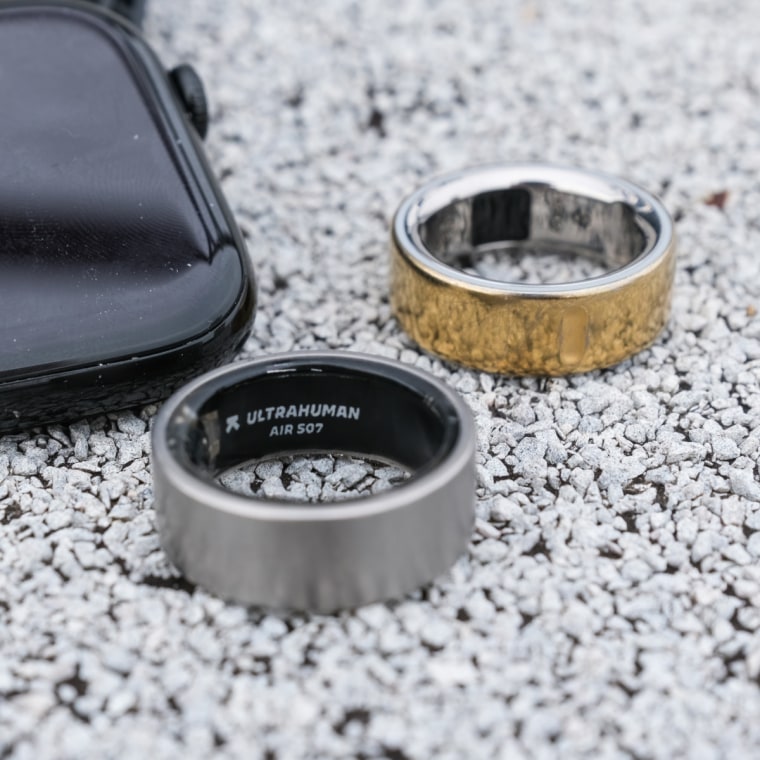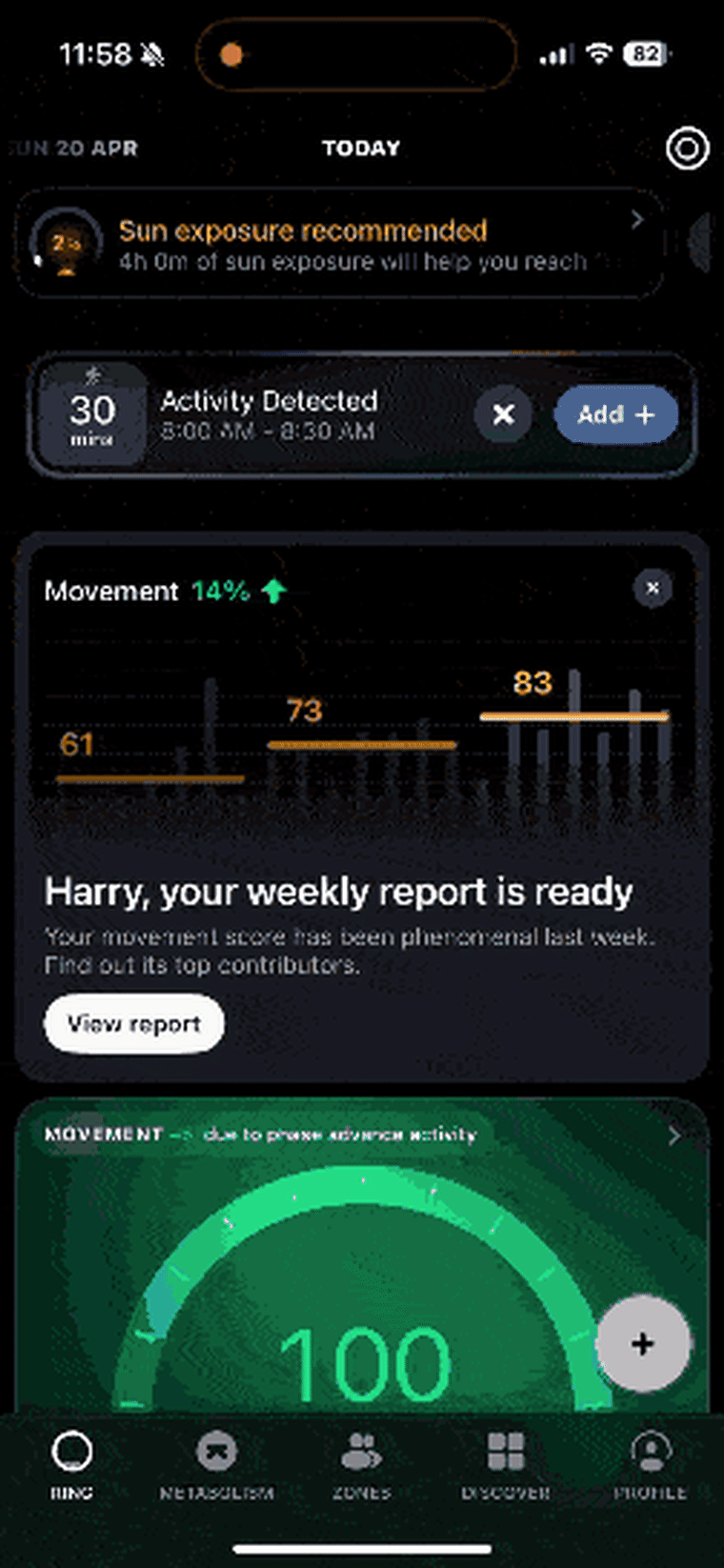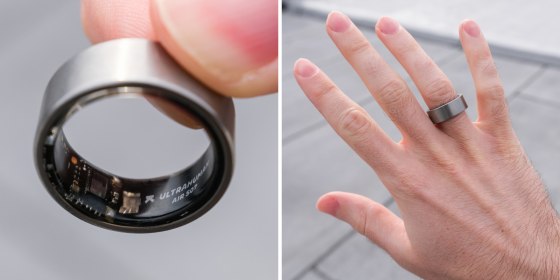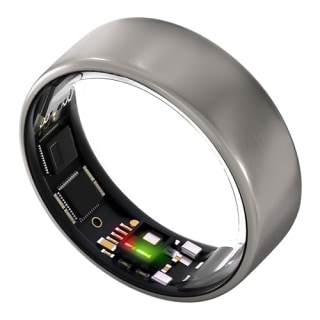What do you want from your wearable tech? That’s the question I kept asking myself while wearing the Ultrahuman Ring Air. Do you want reminders to stretch or go to bed? Do you want a schedule to optimize every minute of exercise in your week? Or do you just want to check your health stats every now and then?
The Ultrahuman Ring Air has a very specific answer, one that’s different from the competition. I wore it daily for two months: here’s everything you need to know.
SKIP AHEAD How I tried the Ultrahuman Ring Air | My experience with the Ultrahuman Ring Air | Who is the Ultrahuman Ring Air for? | Why trust NBC Select?
Want more from NBC Select? Sign up for our newsletter, The Selection, and shop smarter.
What is the Ultrahuman Ring Air?
Ultrahuman Ring Air
- Lightweight and comfortable
- Useful data and suggestions
- No subscription fee
- App can be overwhelming
The Ultrahuman Ring Air ($349) is a smart ring that tracks health, wellness and fitness metrics like heart rate , skin temperature, activity, workouts, stress and more. It automatically detects naps, sleep and some exercise like outdoor walks. You can also manually start and stop workouts or breathing exercises through the app, with dozens of profiles available. (You can also log food and water intake, but I didn’t test this feature.)
You view all of your data and insights through the Ultrahuman app, which is full of charts, graphs and scores for things like your sleep, dynamic recovery, movement index, stress rhythm and circadian rhythm.
The ring does not have a monthly subscription. There are extra features for a monthly fee, but they feel like just that: extra, not key to the core experience.
Weight: 2.4 — 3.6 grams | Thickness: 2.45 — 2.8 mm | Sizes available: 5-14 | Battery life: up to 6 days | Built-in GPS: no | Sleep tracking: yes (including naps) | Heart-rate monitor: yes, with EKG | Water resistance: yes, up to 100 meters (up to 12 hours) | Works best with: Ultrahuman app (iOS or Android)
How I tried Ultrahuman Ring Air

I tested the Ultrahuman Ring Air for two months after the brand sent me a ring sizing kit and ring sample for review. I wore the ring (seen above in the raw titanium color) on my right ring finger, only taking it off to charge. I wore it at the same time as the Oura Ring 4 ($349) and Apple Watch Series 10 ($399). I compared comfort, battery life, accuracy and usability between the three wearables.
My experience with the Ultrahuman Ring Air
The Ultrahuman Ring Air takes an active approach to health tracking. It tries to give you actionable information throughout your day. You’ll receive notifications for things like stretch reminders, the ideal time to drink caffeine or best time to get out and exercise for your circadian rhythm. It’s hands-on, and an intriguing option for people who want to adjust their habits and get in the weeds with their data.
What I like
Slim and comfortable
The Ultrahuman Ring Air lives up to its name: it’s lightweight and comfortable, especially compared to other smart rings I’ve tried. On average, it’s a little over 25% lighter than the Oura Ring 4 and a touch thinner too. That may not sound like a lot, but for a person who doesn’t find rings all that comfortable, it feels substantially more comfortable while sitting on my finger throughout the day.
Actionable suggestions and data insights
As advanced as smart rings are a common complaint I’ve heard people mention is that smart rings don’t do anything. I feel like someone at Ultrahuman took this critique to heart — the app feels designed to move you into action: to drink coffee earlier, to exercise at specific times of day or to be diligent with bedtime.

Like its competitors, the Ultrahuman Ring tracks, analyzes and scores your steps, sleep, stress and recovery. Where things get interesting is in what the brand calls PowerPlugs. PowerPlugs are widgets focused on giving you actionable information and notifications. The ones I tested most were caffeine window, circadian rhythm and sun exposure, though the app also has PowerPlugs for cycle tracking, screentime, social jetlag and more (including some PowerPlugs that require a subscription, like cardio adaptability).
Each PowerPlug sent me notifications throughout the day. Caffeine window sent notifications in the morning, saying now is the time for caffeine, and in the afternoon, saying now is the last time you should drink caffeine. Circadian rhythm sent notifications (and used my iPhone’s Live Tracking feature) to show my circadian phases — mostly my phase advance window, when “bright light exposure and exercise is highly beneficial.” These active notifications encouraged me to change my habits in real time — many wearables keep this kind of advice quiet until you decide to open the app.
In practice, this means that the Ultrahuman app sends you a lot of notifications — I’ve had days where it sends me nearly a dozen. Thankfully, you can customize the quantity of notifications in the settings menu.
Consistent health and wellness tracking

The Ultrahuman Ring provided similar data to my Oura Ring 4, neither wildly out of step with heart rate, movement, exercise and sleep data.
Looking at sleep stages, Ultrahuman logged my frequent tossing and turning at night as being awake more often than the Oura Ring 4 did. The Oura Ring 4 also logged more deep sleep on average than the Ultrahuman ring did. Ultrahuman gave me lower sleep scores on average than Oura did.
Fitness tracking was a similar story, though the Ultrahuman Ring gave me less errors on outdoor runs — Oura would occasionally record correct stats but very incorrect GPS data.
One nice feature with Ultrahuman is that the app will keep a record of workouts detected, but never approved. That means if you forget to open the app for a few days, you can scroll through past days and accept or reject detected exercises, even days after the fact. The Oura ring doesn’t have this: if you forget to open the app for a few days, you can only confirm detected workouts from a day, not days, prior.
Potential drawbacks to keep in mind
Battery life and charging could be better
Battery life is only okay on the Ultrahuman Ring Air, likely due to its lightweight and slim design. It gets up to six days of battery life, but my experience was more like four to five. Competitors like the Samsung Galaxy Ring ($399) and Oura Ring 4 get up to seven and eight days respectively.
But the real issue is charging — it’s slow. Like, painfully slow. The Ultrahuman Ring Air takes about 180 minutes to fully charge from 0%. That’s slower than the Oura Ring 4 (up to 80 minutes), Samsung Galaxy Ring (up to 90 minutes), RingConn Gen 2 Air (up to 120 minutes), Apple Watch Series 10 (up to 90 minutes), the list goes on.
The app uses technical language often
The Ultrahuman Ring app constantly uses language I was unfamiliar with. For PowerPlugs like caffeine window and circadian rhythm, get comfortable with phrases like phase advance, phase decay and phase delay, plus terms like minima zone and sympathetic activation. The app does a decent job explaining these concepts if you dive a little deeper, but at a glance, it can be confusing.
It doesn’t help that the app can lean into that terminology, like an overly-eager friend trying to impress. I got a daily notification that read “Incoming Body Signal...Click to decode” — this could easily read “your daily insights are here” instead.
I understand that it’s important for Ultrahuman to feel distinct from the competition. But using big words when small words would suffice is not how I would choose to stand out.
The app can feel clunky to navigate
Aside from technical language, the app just feels a bit clunky and scattered.

The main navigation tabs at the bottom of the app are Ring, Metabolism, Zones, Discover and Profile. 95% of your insights and metrics are in the Ring section, the others, especially Metabolism and Zones, feel so outside the core ring functionality that I wish ring-centric metrics like sleep or dynamic recovery could take their place on the home page instead.
The Ring tab itself is a bit busy because each metric is displayed in such a disparate way. The movement summary looks like a speedometer, caffeine window is a line graph, dynamic recovery is a bar graph — but when you click in for more details, all of them show simple bar graphs with suddenly unified design language.
And if I haven’t opened the app all day, it takes a while to sync, and often won’t let me do anything until the ring finishes syncs. This can take anywhere from eight seconds to 20, slower than competitors like Oura, in my experience.
Who is the Ultrahuman Ring Air for?
If all this talk of PowerPlugs, phase advance windows and design language has you checked-out, then the Ultrahuman Ring Air probably isn’t for you. For accurate health tracking that’s holistic and approachable, the latest Oura Ring 4 is excellent. If you are all-in on Samsung devices, the Samsung Galaxy Ring is easy to use and seamless.
But if you want something more active and technical, the Ultrahuman Ring Air might be the best smart ring for you. It’s a fascinating wearable for a specific kind of person. It’s for tinkerers, health nerds and optimizers. It’s for anyone who wants their wearable to tell them what to do in the moment, rather than sit back and make suggestions when you open the app at the end of the day. It’s for people who are curious about health and science-y terms, not intimidated. And it’s for people who cannot stand the idea of paying for yet another monthly subscription service.
Why trust NBC Select?
I am a reporter at NBC Select who covers technology and fitness including recent stories on smartwatches, running shoes, workout earbuds and more. For this piece, I wore the Ultrahuman Ring Air daily for over two months after the brand sent me one to try. I tracked my daily stats, sleep and exercise and compared the fit and feel of the Ultrahuman Ring Air to other wearables on the market.
Catch up on NBC Select’s in-depth coverage of tech and tools, wellness and more, and follow us on Facebook, Instagram, Twitter and TikTok to stay up to date.




